Poverty Incidence
In the first semester of 2021, a family of five in Region X needed, on average, PhP 11,920 per month to meet their basic food and non-food needs. This is 16.7 percent higher than the monthly average amount of PhP 10,215 needed to meet the minimum basic food and non-food needs of a family of five in the same period of 2018. This amount needed to meet the basic food and non-food needs is called the poverty threshold.
The proportion of poor families in Region X whose income is not sufficient to meet their basic food and non-food needs, that is, their income is less than the poverty threshold or the poverty incidence among Region X families, was estimated at 26.2 percent. This is equivalent to around 312 thousand poor families in the region.
Among the population, the poverty incidence was recorded at 33.8 percent or about 1.72 million individuals in the region living below the estimated regional poverty threshold.
Lanao del Norte posted the highest poverty incidence while City of Cagayan de Oro recorded the lowest poverty incidence
Among the provinces and HUCs in the region, Lanao del Norte posted the highest poverty incidence among families in the first semester of 2021 with 39.1 percent. This translates to around 62,900 families in Lanao del Norte who lived in poverty in the first semester of 2021. Likewise, the province recorded the highest poverty incidence among population at 48.6 percent in the same period of 2021 which is equivalent to about 365,100 persons in the province whose income was below the monthly poverty threshold of PhP 11,710 for a family of five during the said period.
Meanwhile, City of Cagayan de Oro posted the lowest poverty incidence among families at 11.6 percent. This is equivalent to about 22,600 families in the city whose family income was below the poverty threshold of PhP 11,975 per month for a family of five in the first semester of 2021. In the same manner, the city also posted the lowest poverty incidence among population estimated at 17.4 percent. This translates to around 130,400 poor individuals in the city. (Table 1)
Table 1. First Semester Poverty Threshold, Poverty Incidence, and Magnitude of Poor in Region X by Province/HUC: 2018 and 2021
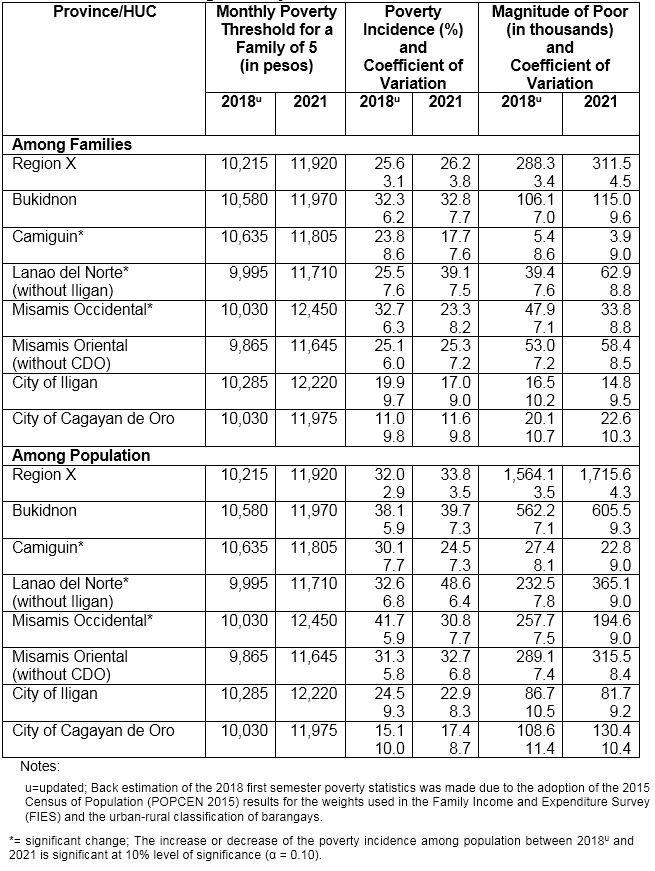
In terms of magnitude of poor families and poor population, Bukidnon recorded the largest number of poor population and poor families in the region
Bukidnon recorded the largest number of poor families in the region with 115 thousand families or 36.9 percent of the total poor families in Region X. Likewise, Bukidnon registered the largest number of poor population at 605,500 poor individuals or 35.3 percent of the total poor population in Region X. (Figure 1 and Figure 2)
Figure 1. Percent Distribution of Poor Families in Region X by Province: First Semester of 2021
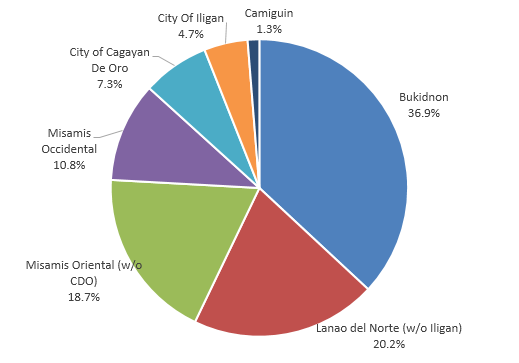
Note: Details may not add up due to rounding.
Figure 2. Percent Distribution of Poor Population in Region X by Province: First Semester of 2021
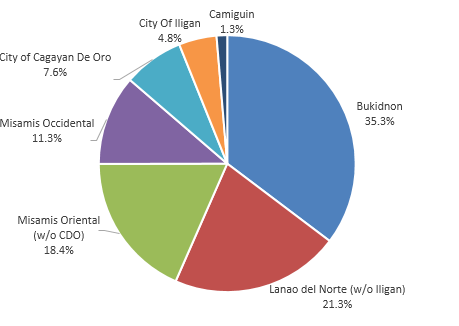
Two provinces posted significant decrease in poverty incidence among families and among population
Misamis Occidental posted the highest significant improvement in poverty incidence among families from 32.7 percent in the first semester of 2018 to 23.3 percent in the same period of 2021, bringing down the poverty incidence by 9.4 percentage points. Moreover, Camiguin also posted a significant decrease in poverty incidence among families by 6.1 percentage points, that is, from 23.8 percent in the first semester of 2018 to 17.7 percent in the same period of 2021.
In addition, poverty incidence among population also improved significantly by 10.9 percentage points in the province of Misamis Occidental, that is, bringing down the poverty incidence among population to 30.8 percent in the first semester of 2021 from 41.7 percent in the same period of 2018. Likewise, Camiguin’s poverty incidence among population significantly improved from 30.1 percent in the first semester of 2018 to 24.5 percent in the same period of 2021. (Table 1)
Lanao del Norte recorded a significant increase in poverty incidence among families and among population
Poverty incidence among families in Lanao del Norte increased significantly by 13.6 percentage points, that is, from 25.5 percent in the first semester of 2018 to 39.1 percent in the same period of 2021. This increase of poverty incidence translates to an additional 23,500 poor families in the province bringing the total number of poor families in the province to 62,900 in the first semester of 2021.
Moreover, poverty incidence among population in Lanao del Norte also increased from 32.6 percent in the first semester of 2018 to 48.6 percent in 2021, posting a significant increase of 16.0 percentage points. (Table 1)
Subsistence Incidence
The proportion of families in Region X whose family income was less than the monthly food threshold (PhP 8,305) or the monthly amount needed to meet the basic food needs for a family of five in the first semester of 2021 was estimated at 10.9 percent. This is a significant increase of 1.5 percentage points from the recorded subsistence incidence among families in the first semester of 2018 at 9.4 percent. This significant increase implies an additional 23,600 food poor families in the region in the first semester of 2021 leading to total number of 129,500 families in Region X who cannot afford even their basic food needs in the first semester of 2021.
Among the population, subsistence incidence for the same period was estimated at 15.0 percent, a significant increase of 2.3 percentage points from the recorded subsistence incidence of 12.7 percent in the first semester of 2018. Subsistence poor population in Region X increased to 762,100 individuals in the first semester of 2021 from 620,700 persons in the same period of 2018, lowering the number of food poor families in the province by 9,600 families. (Table 2)
Misamis Occidental posted significant decrease in subsistence incidence among families
Misamis Occidental posted a significant improvement in subsistence incidence among families from 12.9 percent in the first semester of 2018 to 6.5 percent in the same period of 2021. This is an improvement of 6.4 percentage points in its subsistence incidence among families. (Table 2)
Lanao del Norte’s subsistence incidence among families significantly increased
There was a significant increase in the subsistence incidence among families in the province of Lanao del Norte. The subsistence incidence significantly increased by 10.6 percentage points, that is, from 8.2 percent in the first semester of 2018 to 18.8 in the same period of 2021. Such incidence is equivalent to around 30,300 families in the province during the first semester of 2021 whose family income cannot afford to buy their basic food needs, that is, their family income was below the monthly threshold of PhP 8,160 for a family of five. (Table 2)
Table 2. First Semester Food Threshold, Subsistence Incidence, and Magnitude of Subsistence Poor in Region X by Province/HUC: 2018 and 2021
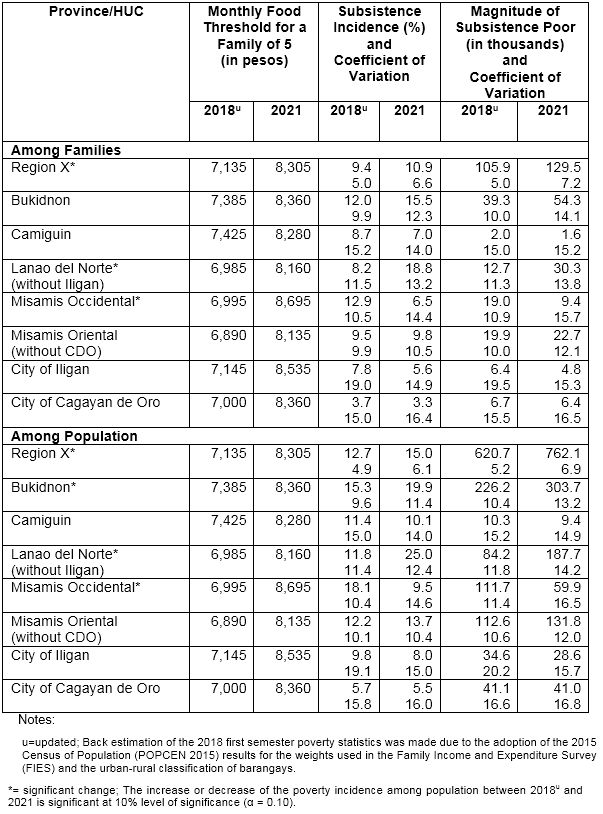
Two provinces recorded significant increase in subsistence incidence among population
Lanao del Norte posted the highest significant increase of 13.2 percentage points in subsistence incidence among population. The proportion of poor individuals in Lanao del Norte who lived below the food threshold increased from 11.8 percent in the first semester of 2018 to 25.0 percent in the same period of 2021. This translates to about 187,700 food poor individuals in the province during the first semester of 2021.
In addition, Bukidnon also recorded a significant increase of 4.6 percentage points in subsistence incidence among population, that is, from 15.3 percent to 19.9 percent. This is equivalent to around 303,700 food poor individuals in the province of Bukidnon in the first semester of 2021. (Table 2)
Poverty Cluster Analysis
In the first semester of 2021, Camiguin and Misamis Oriental belonged to Cluster 4 while Bukidnon and Lanao del Norte belonged to Cluster 2. Misamis Occidental, on the other hand, belonged to the middle cluster (Cluster 3).
Two provinces moved to lesser poor cluster, namely, Camiguin –from Cluster 3 to 4 and Misamis Occidental –from Cluster 2 to 3. However, Lanao del Norte moved to a poorer cluster, that is, from Cluster 3 to Cluster 2. (Table 3)
Table 3. Clustering of Provinces based on 2021 First Semester Poverty Incidence among Families: 2018 and 2021
(where Cluster 1 indicates the bottom (poorest) cluster of provinces)

Other Measures of Poverty
The income gap measures the average amount of income required by the poor in order to get out of poverty expressed in relation to the poverty thresholds. In the first semester of 2021, the income gap for Region X was estimated at 27.9 percent. This means that the average per capita income of the total poor families is short by 27.9 percent of the poverty threshold. This means that a family of five in Region X needed, on the average, an additional monthly family income of PhP 3,326 to stay out of poverty in the first semester of 2021.
Lanao del Norte registered the largest income gap of 31.3 percent while Misamis Occidental posted the lowest income gap of 21.2 percent
Among the provinces and HUCs, Lanao del Norte posted the largest income gap of 31.3 percent, closely followed by Bukidnon with 31.0 percent. This means that on the average, a poor family of five in Lanao del Norte and Bukidnon needed, on the average, an additional monthly family income of PhP 3,665 and PhP 3,711, respectively, to move out of poverty in the first semester of 2021.
Meanwhile, Misamis Occidental registered the lowest income gap in the first semester of 2021 at 21.2 percent, which means that on the average, a poor family of five in the province needed an additional monthly income of PhP 2,639 to become non-poor.
Table 4. First Semester Income Gap, Poverty Gap and Severity in Region X by Province/HUC: 2018 and 2021
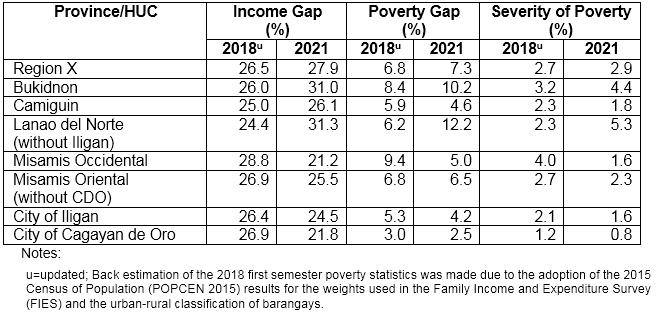
Moreover, Region X posted a poverty gap of 7.3 percent in the first semester of 2021. This means that the total population in the region has an income shortfall of 7.3 percent of the poverty threshold. This can serve as a useful reference in determining the total cost of eliminating poverty among the whole population.
Lanao del Norte had the largest poverty gap of 12.2 percent while City of Cagayan de Oro had the lowest poverty gap of 2.5 percent
Lanao del Norte also posted the largest poverty gap of 12.2 percent. This means, that on the average, the per capita income shortfall of the Lanao del Norte population in the first semester of 2021 was estimated at PhP 1,714.
Meanwhile, Cagayan de Oro with the lowest poverty gap of 2.5 percent showed an average per capita income shortfall of its total population of PhP 359 in the first semester of 2021.

